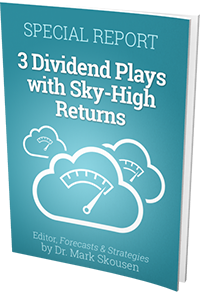Imagine a door that opens and closes, letting electricity flow through or stop it in its tracks.
Now, imagine that same door opening and shutting in picoseconds (trillionths of a second).
Now, imagine over 100 billion of those on a piece of silicon that’s smaller than the palm of your hand.

Modern semiconductors are amazing feats of science.
Just think that they started with one door (transistor) at relatively slow speeds.
Over decades, the number of transistors that fit onto a single microprocessor grew from thousands to millions to billions.
It’s pretty amazing that George Gilder called the trend back in the 1980s!
Today’s semiconductors work on scales smaller than we can see with the human eye.
Now, we all know the names of the top players in the industry: Intel, AMD, NVIDIA, Taiwan Semiconductor, etc.
But have you ever stopped to think about how they make their processors?
It turns out there’s one company with a stranglehold on the entire semiconductor industry.
But that may not last forever.
The race to deliver the next generation of processors has brought us to an inflection point.
COVID-19 showed the world’s great powers the fragility of our supply chains.
Countries aren’t interested in relying on one company to deliver equipment that ships in… no joke… 40 containers.
Changes are being made right now…
…changes that could shift the balance of power in the world.
…changes that could usher in the next technological revolution.
ASML:The Dutch Wonder
No advanced semiconductor produced today, whether for your iPhone or Tesla, can be made without equipment made by ASML Holding.
For nearly two decades, this Dutch company has manufactured the equipment foundries use to make the world’s most advanced microchips.
With a monopoly on extreme ultraviolet lithography (EUV), ASML holds the keys to 5G…
…or so we thought.
ASML abides by sanctions against China, refusing to ship them EUV equipment. However, it sells them deep ultraviolet lithography machines, the next step down.
It turns out China figured out how to retool less advanced DUV models to produce seven-nanometer and potentially even more advanced chips, giving their golden child, Huawei, access to technology it shouldn’t have.
Typically, it’s cost-prohibitive to upgrade the equipment like this. But with the government footing the bill, Chinese foundries have been stockpiling DUV gear for years.
In fact, ahead of the latest restrictions, China boosted orders, increasing their percentage of ASML’s revenue from 8% in Q1 of this year to 46% in Q3.
Sorry to say, but anyone considering jumping on the ASML investment train is getting on at the last stop.
With sanctions snapped in place and a recession on the horizon, ASML lowered its forecast for the remainder of 2023 and into 2024.
However, this is only Act I of the semiconductor story.
It’s Act II where things get really interesting.
No Moore
Moore’s Law says the number of transistors that can fit onto a microchip should double every few years.
As the size of transistors shrinks, the methods and technology required to build the next generation of semiconductors get more and more complex.
Yet, we may be approaching the limits of physics.
Although we can’t see it, transistors have extremely thin barriers and spaces between them.
The smaller we make them, the thinner those barriers become.
When they become too thin, electrons can skip through these transistors, causing unintended current flows, an effect known as “quantum tunneling.”
This creates serious problems, from increased power consumption to unreliable or lost data.
In theory, this occurs when the transistors are spaced just a few atoms apart. However, engineers and designers have seen this in today’s processors.
Luckily, they’re able to work around and through it by employing clever design techniques and material choices.
It’s unclear how much further ingenuity will take us before we reach the limits of classical physics and the weird world of quantum physics takes over…
…which brings us to our third and final act.
Not Quite ‘Star Trek’
Our next generation of semiconductors won’t follow just one path.
There are two independent avenues, each of which is unique… and exceptionally lucrative.
The first follows Ant-Man down to the subatomic level with quantum computers.
You’ve probably heard these mystical mechanisms can crack any password and model complex problems in seconds that classical computers would take decades to solve.
This is true… kind of.
Quantum computers are great at running the same process in parallel simultaneously, making them ideal when you want to break into someone’s bank account. Just throw a quantum computer at the problem, and it’ll try a billion passwords in a flash.
However, it won’t help you access that webpage any faster.
Think of computer processing like a man on a journey. After walking for miles, he hits a crossroads.
He could walk a little ways down each path to see where it goes and then choose the right one.
Quantum computers can do this faster than classical computers.
But those miles he walked before he came upon that crossroads won’t go by any quicker for a quantum computer.
For that, we need a new way to handle classical computer processing…
…which brings us to graphene.
Yes, we’ve talked about the wonder material before.
But here’s where it gets interesting.
Graphene has high electron mobility, allowing data processors to move faster.
Its unique, atom-thick, hexagonal lattice structure makes it easier to dissipate heat, making it more energy efficient.
But the big gains come in optical computing, a type of processing that would be orders of magnitude faster than today’s processors.
Interestingly, these same properties make quantum tunneling far less likely on a graphene processor than a classical one.
This really only scratches the surface of graphene’s potential to revolutionize the semiconductor industry.
But one thing is for certain, the ones to invest in this technology will be the ones that will control our future.
We’re not just talking about an industry of billions, but trillions.
That’s what awaits us.
George Gilder put together an incredible report that explains in detail how the average investor can get in at the beginning of what could be the largest windfall in decades.




